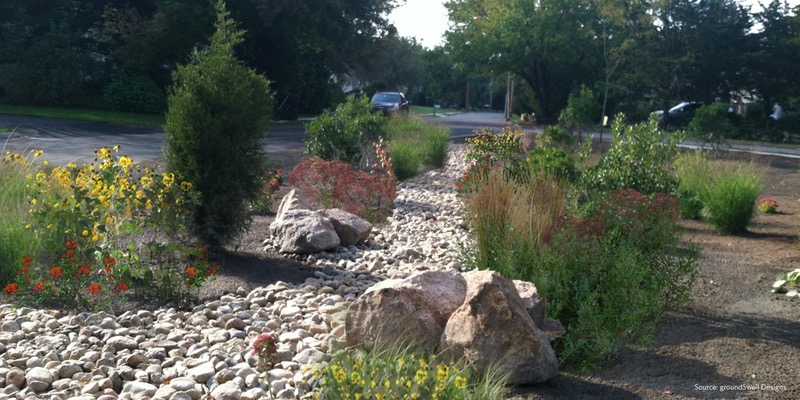
An example of a rain garden, where stormwater can percolate into the ground instead of going into storm drains.
The Town of Watertown has multiple incentives to reduce the amount of rain water flowing into storm drains and eventually into the Charles River, including preventing street flooding and reducing the amount of pollution going into the river – which will be part of the new and stricter Environmental Protection Agency (EPA) requirements.
The EPA requirements come out in Jul and the town will receive a new permit which will include more stringent requirements to reduce pollution of the river. The Department of Public Works seeks to find ways to prevent rain water from running down streets and driveways into storm drains, and out into the Charles River, because stormwater is a major cause of pollution in the river.
Sometimes small storms can be worse for pollution than bigger ones, Shuman said.
“We call it the first flush,” Shuman said. “The first quarter inch of rain picks up all the pollutants from the roads and it runs into the storm drains.”
Looking to encourage ways to divert water from going into storm drains, the Town will host a workshop to teach residents about how to use and how to design a rain garden on their own property.
“This is a first for us working with the Stormwater Advisory Committee and the Charles River Watershed Association,” said Town Engineer Matt Shuman.
A rain garden in Watertown helps protect the Charles River by allowing more rainwater to percolate into the ground, rather than going into the storm drains, which can carry pollutants and silt into the river.
Shuman said modern stormwater strategies, such as a bio-retention area, are more attractive than the old style retention ponds. They can collect several inches of water under a surface, which has rocks or gravel and is planted with grasses, plants and sometimes trees.
“A rain garden is something you might do at your house,” Shuman said. “You can direct your downspout into the garden instead of having it go where it goes (now).”
The plants in a rain garden must be the right kind – ones which can handle large amounts of water at one time and also drought resistant ones, Shuman said.
At the workshop, attendees can see some of the bioretention areas at the recently renovated office complex at 65 Grove Street (formerly GE Ionics). The workshop will be lead by award-winning landscape design firm groundSwell and will be held on Saturday, May 6 from 1:30-4 p.m. at 65 Grove Street in Watertown.
Space is limited. Regsister at https://watertown-rain-garden-
The DPW is planning some bioretention projects of its own around town. Some will be on Edenfield Avenue. The project is a Green Pilot where a variety of different bioretention strategies will be used in the planting strips on the sides of the road, Shuman said.
“Residents will not notice the catch basins below the planting strips,” Shuman said. “They will see a regular landscaped border and street trees. We will try both grass and some with other plants and see which people like more.”
Residents are supposed to care for the planting strips in front of their homes, Shuman said, and the plants planned to be used instead of grass will require less maintenance than grass.
“Grass has to be mowed every week or two, but the kinds of plants we will use need to be cut once a year, maybe twice,” Shuman said.
A much larger bioretention area is planned for Beacon Park, where the town will close off the entrance to Arsenal Street and put in a planted area. That area will be maintained by the town.
Other areas where new stormwater projects are planned are at Hosmer School at Hancock Street, and on Common Street, where four or five bioretention areas will be included in the renovation and redesign of the street. The project also includes adding a rotary in the intersection of Common, Orchard and Church streets.
The DPW will also be going around town to clean the 3,200, or so, catch basins around Watertown, and sweeping the streets.
Very encouraging to see these efforts to improve our stormwater management in Watertown. These innovative projects will improve water quality in the Charles River, reduce flooding as storms become more intense due to climate change, and create attractive landscaped areas. A win/win/win. Thanks!
If it hasn’t been already it would be wise to incorporate where possible the use of rain gardens and other WQ enhancement techniques into Phase 2 of the Arsenal development and others. These large developments are certainly a significant stormwater source. Ideas such as rain gardens that avoid point source stormwater fast impulse discharges and instead reroute and percolate to groundwater and then to slowly recharge surface water into the plan can only be beneficial in myriad of ways.
If it hasn’t been already it would be wise to incorporate where possible the use of rain gardens and other WQ enhancement techniques into Phase 2 of the Arsenal development and others. These large developments are certainly a significant stormwater source. Ideas such as rain gardens that avoid point source stormwater fast impulse discharges and instead reroute and percolate to groundwater and then to slowly recharge surface water into the plan can only be beneficial in myriad of ways.